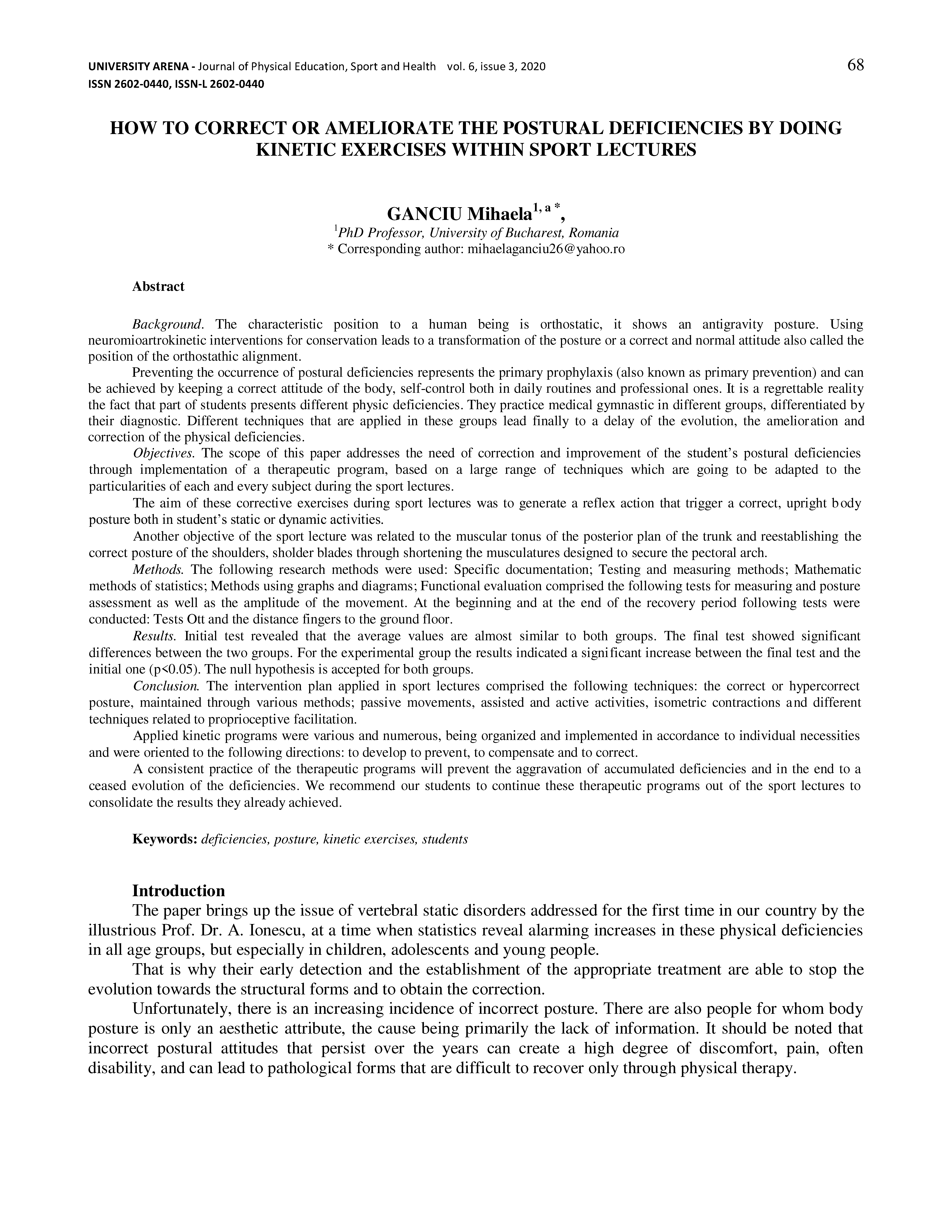HOW TO CORRECT OR AMELIORATE THE POSTURAL DEFICIENCIES BY DOING KINETIC EXERCISES WITHIN SPORT LECTURES
DOI:
https://doi.org/10.62229/UaVi_3_20-10Keywords:
deficiencies, posture, kinetic exercises, studentsAbstract
Background. The characteristic position to a human being is orthostatic, it shows an antigravity posture. Using
neuromioartrokinetic interventions for conservation leads to a transformation of the posture or a correct and normal attitude also called the position of the orthostathic alignment. Preventing the occurrence of postural deficiencies represents the primary prophylaxis (also known as primary prevention) and can be achieved by keeping a correct attitude of the body, self-control both in daily routines and professional ones. It is a regrettable reality the fact that part of students presents different physic deficiencies. They practice medical gymnastic in different groups, differentiated by their diagnostic. Different techniques that are applied in these groups lead finally to a delay of the evolution, the amelioration and correction of the physical deficiencies.
Objectives. The scope of this paper addresses the need of correction and improvement of the student’s postural deficiencies through implementation of a therapeutic program, based on a large range of techniques which are going to be adapted to the particularities of each and every subject during the sport lectures. The aim of these corrective exercises during sport lectures was to generate a reflex action that trigger a correct, upright body
posture both in student’s static or dynamic activities. Another objective of the sport lecture was related to the muscular tonus of the posterior plan of the trunk and reestablishing the correct posture of the shoulders, sholder blades through shortening the musculatures designed to secure the pectoral arch.
Methods. The following research methods were used: Specific documentation; Testing and measuring methods; Mathematic methods of statistics; Methods using graphs and diagrams; Functional evaluation comprised the following tests for measuring and posture assessment as well as the amplitude of the movement. At the beginning and at the end of the recovery period following tests were conducted: Tests Ott and the distance fingers to the ground floor.
Results. Initial test revealed that the average values are almost similar to both groups. The final test showed significant differences between the two groups. For the experimental group the results indicated a significant increase between the final test and the initial one (p<0.05). The null hypothesis is accepted for both groups.
Conclusion. The intervention plan applied in sport lectures comprised the following techniques: the correct or hypercorrect posture, maintained through various methods; passive movements, assisted and active activities, isometric contractions and different techniques related to proprioceptive facilitation. Applied kinetic programs were various and numerous, being organized and implemented in accordance to individual necessities and were oriented to the following directions: to develop to prevent, to compensate and to correct. A consistent practice of the therapeutic programs will prevent the aggravation of accumulated deficiencies and in the end to a ceased evolution of the deficiencies. We recommend our students to continue these therapeutic programs out of the sport lectures to consolidate the results they already achieved.


